Edward Wallick - 34th Ohio Infantry Co. D
36th Ohio Infantry Co. D
Rank: Private
Place of enlistment: Lima, Ohio - February 3, 1864
Mustered into Federal service: February 15, 1864
Service Time: 1 year, 4 months
Born: December, 1844 - Coshocton County, Ohio
Residence: Ada, Ohio
Age at enlistment: 19
Height: 5'9" dark hair, blue eyes
Civilian occupation: Farmer
Family Lineage
Edward, son of Samuel, son of “Bunker Hill” Michael, son “Bedford” Michael, son of Hans Michael and Esther Wallick
In the late fall of 1863 the family of Samuel Andrew Wallick had just finished harvesting their crops when they received stunning news from the war front. They had been shorthanded on their Harding County, Ohio farm for the past two years ever since Samuel’s eldest son, Isaiah, left to join in the fight to suppress the southern rebellion. He and his regiment, the 49th Ohio, had been in some of the bloodiest engagements of the war. Before the rebellion names such as Chickamauga Creek, Shiloh Church and Murfreesboro were just remote specks on a southern map. Now they were synonymous with savage, brutal fighting and the 49th Ohio had been in them all. The Union losses in these engagements were staggering and horrific. But now, for once, there was good news from the south about this war.
Shortly after Thanksgiving, Samuel Wallick's family learned of the most amazing and glorious victory the Union Army had achieved thus far on a battlefield. Perhaps the fortunes of war had now turned in favor of the Federal troops, for they had made a spectacular charge up Missionary Ridge, just outside of Chattanooga, Tennessee and throughly thrashed the Rebels. Isaiah and his regiment were part of this heroic endeavor. The Union Army had a line of battle that stretched for two miles and was 24,000 men strong. When they stormed out of their positions to dislodge the entrenched Confederates, the Union troops were unstoppable. After taking the works at the base of the 600-foot ridge, the Federals did not halt as ordered but continued to chase the Rebel Army all the way up to the top of the ridge. The success of this grand assault was an important step toward the death of the Confederacy. For Samuel Wallick the news of this stunning Union victory was soon tempered by news that his son, Isaiah, had been killed during the battle. The charge up Missionary Ridge took place on the day before Thanksgiving, November 25, and Isaiah became mortally wounded sometime during the attack. He was taken to a hospital in Chattanooga where he struggled all through the holiday with his wounds, but they were too severe and he died the day after Thanksgiving, November 27, 1863.
Edward Wallick c.1900

Edward Wallick was just a few weeks shy of his nineteenth birthday when brother Isaiah was killed at Missionary Ridge. Edward was born in Coshocton County, Ohio (as were all of Samuel’s children), but moved to Ada, Ohio, as a youth. When the war broke out in 1861, Isaiah was quick to enlist, leaving Edward the only son to help on the farm. Isaiah's death could have brought bitterness to Samuel and his family. However, Edward volunteered for service just two months after the death of his brother. He could have waited to be drafted or tried to avoid military service altogether. He did neither. It seems more likely that Edward volunteered out of his sense of patriotism and honoring his brother’s sacrifice.
Edward Wallick with the 34th & 36th Ohio Volunteer Infantry
1864
FEB 3 Edward Wallick enlists in Lima, OH for 3 years as a volunteer recruit. He is eventually paid a $100 bounty and due $200 more by the Federal Government (although his record states that $84.15 will be deducted “for clothing in kind or money advanced.”)
Enlistment document for Edward Wallick, dated February 3, 1864.
In lieu of his signature he made his mark, witnessed by W. A. Bearinger.
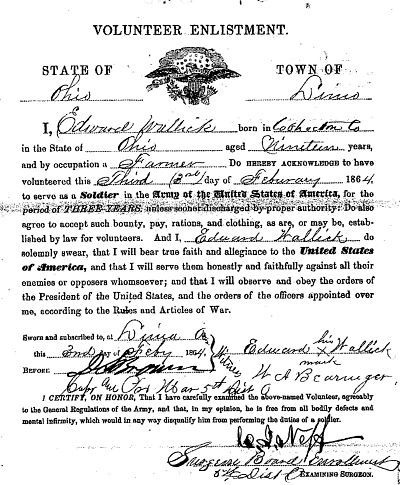
FEB 27 Edward is assigned to Company D, 34th Ohio Volunteer Infantry, and joins the unit as a new recruit at Charleston, WV.
MAY 1 General Crook's Expedition against the Virginia & Tennessee Railroad The 34th Ohio is divided into two columns on April 29th. One is mounted infantry, which goes with General Averill and his cavalry, and one is dismounted infantry, which goes with General Crook and his infantry division. On May 1st General Crook sets out from Charleston, WV to break up the Virginia & Tennessee Railroad and destroy the New River Bridge near Newbern Court House, VA. Since it would have been easier for a new recruit to assimilate into a dismounted infantry unit versus a mounted infantry unit, it is believed that Edward is with General Crook's division.
MAY 9 Battle of Cloyd’s Mountain General Crook learns that the Rebels occupy the summit of Cloyd’s Mountain, near Dublin, VA and prepares to dislodge them. The Federal forces must cross open ground under heavy musket and artillery fire. They make a successful charge and drive the enemy from the field.
MAY 10 General Crook destroys the New River Bridge The main goal of the expedition is achieved when Union forces defeat the Confederates guarding the Virginia & Tennessee Railroad Bridge over the New River. The bridge is totally destroyed. They then move and capture the Confederate stores and supplies at Dublin Depot.
JUN 6 Skirmish at Buffalo Gap The 34th is part of future President Rutherford B. Hayes’ brigade. They have a skirmish with the Rebels at Buffalo Gap, where they succeed in driving them out of the pass. General Hayes will be Edward's brigade and division commander for much of his enlistment in the 34th Ohio.
JUN 8 General Crook, with Edward and the 34th Ohio, arrive at Staunton, VA and make their final preparations to join General Hunter in what is to become a disastrous raid on Lynchburg, VA.
JUN 16 The 34th Ohio reaches Liberty, VA. After crossing the Blue Ridge Mountains they have a skirmish with the Confederates outside town.
JUN 17-19 Raid on Lynchburg, VA. General Crook sends the 34th Ohio’s brigade on a flanking expedition across the James River for the purpose of attacking Lynchburg from the rear while the cavalry on their left makes a diversionary probe. The attack is made late in the day on the 18th and is partially successful. In the opinion of Lt. Colonel Franklin, commanding officer of the 34th Ohio, the attack would have been entirely successful had orders from General Hunter not forbade the Union forces from occupying the city that night. Lynchburg is reinforced by 20,000 Confederate soldiers from General Early’s command at Richmond overnight. The next morning the Rebels open the day with a fierce cannonade and the Federals answer back with their own barrage. In the afternoon there is an engagement and the 34th Ohio suffers severely. At dark on the evening of June 19th the Federal forces must retreat. The Rebels pursue the Union forces and there is a second skirmish at Liberty, VA.
JUN 21 Engagement near Salem, VA at Catawba Mountain The enemy continues to press the retreating Federals and attack the unsupported artillery of General Hunter’s command while it passes through a narrow gap at Catawba Mountain. The Rebels suddenly descend from the hills, dispersing drivers and gunners. They continue their savage attack by shooting horses, cutting their harnesses and blowing up caissons. The mounted portion of the 34th Ohio, being a few miles away, hurries to the scene and counterattack. The Rebels are driven off after a sharp engagement and the Federal retreat continues.
JUL 1 The Federal forces are continually harassed by the enemy as they march through the eastern mountains of West Virginia. They arrive at Charleston on July 1, 1864 exhausted, ragged and half-starved. General Hunter’s “Retreat from Lynchburg” is a disaster long remembered by the men of the 34th Ohio.
JUL 12-15 34th moved to Shenandoah Valley Edward and the 34th Ohio moves from Charleston WV to Martinsburg, VA in the Shenandoah Valley.
JUL 20 Engagement at Stephenson’s Depot The 34th Ohio has a forced march from Martinsburg to Stephenson’s Depot (two miles north of Winchester, VA) in an effort to check the Confederate advance. The outnumbered Federal forces engage the Rebels, capture their artillery and kill or wound all their brigade commanders. The losses to the 34th Ohio are 10 killed and 20 wounded.
JUL 24 Battle of 2nd Kernstown Confederate General Jubal Early is attacking in the Shenandoah Valley as a diversion to make General Grant pull some of his Federal troops from besieged Petersburg, VA. The 34th Ohio is sent west out Romney Rd., just north of Kernstown, to protect the Federal right flank. They are not engaged until the afternoon to help cover the Union Army retreat.
AUG 24 The 34th Ohio is sent to Harper’s Ferry to protect that vital possession from an attack by General Early.
SEP 3 Edward and his regiment are moved south to Berryville, VA, about eight miles east of Winchester, VA.
SEP 19 Battle of Opequon Creek (or 3rd Winchester) The morning of battle, Edward and his brigade have moved to where the Winchester-Berryville Pike and Opequon Creek cross, just east of Winchester, and are held there in reserve all morning. At this time Elias Wallick is engaged just north of the Berryville Pike and mortally wounded (see Elias Wallick- Battle of Opequon Creek). At noon the 34th Ohio moves west toward Winchester and is positioned on the battlefield north of Red Bud Run, where they can support an attack by the Federal right flank. Edward is still in General Hayes' brigade and they deploy for battle about 4:00 PM. The brigade advances parallel and north of Red Bud Run, then wheels to the left and charges into the Confederates. There is pressure all along the Federal line and the Confederates finally break and stream back into Winchester as a disorganized mob.
Edward and the 34th Ohio Infantry moved across
this ground on their way to the Battle of Opequon Creek.

Below is Red Bud Run on the Opequon Creek Battlefield. Once across Red Bud Run, Edward and the 34th Ohio engaged the Rebels and pushed them to, then through, Winchester, VA in a total rout. The Confederates didn't stop retreating until they found favorable ground twenty miles farther south, at Fisher's Hill.
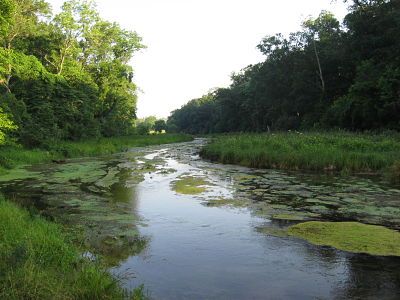
SEP 22 Battle of Fisher’s Hill Confederate General Early tries to make a stand at Fisher’s Hill after his defeat at the Battle of Opequon Creek. The Confederates have chosen a naturally strong position to defend and are well entrenched. General Sheridan orders Edward’s division to Little North Mountain, where they slam into the Confederate left at about 3:30 PM. The Rebels are rolled up on the left as the Union attacks the center and the Confederate line breaks from their trenches. By the end of the day General Early has lost sixteen guns and 1,000 men are taken prisoner.
Below is the Confederate position at the Battle of Fisher's Hill. The Confederates formed their line of battle in this open field, perpendicular to the horizon. The 34th Ohio was positioned on the distant ridge. During the attack the Federal forces charged down from the hills into the Confederate left flank, driving them from the field.
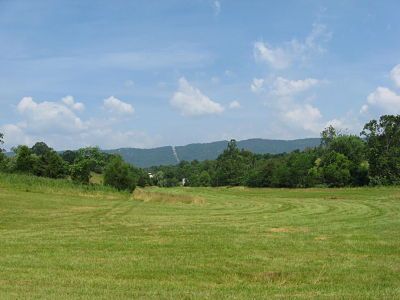
OCT 19 Battle of Cedar Creek Union General Sheridan has continued to press the Confederate forces in the Shenandoah Valley. General Early decides to make one last attempt at pushing the Federals back down the valley. On October 17-18 he makes his preparations for an early morning attack on the 19th. The Confederates storm into the unsuspecting Union camps that morning which initiates a Federal panic and general retreat. Edward’s VIII Corps is the first camp to be assaulted by the Rebels and the fleeing troops quickly move through other Federal campgrounds. The attack happens so fast that by late morning all seems lost for the Union Army .
Edward's VIII Corps was camped here on the morning of October 19, 1864 when the Confederates, under General Jubal Early, made a surprise attack and drove the entire Union Army miles to the rear. By midday the Federals were in total disarray.
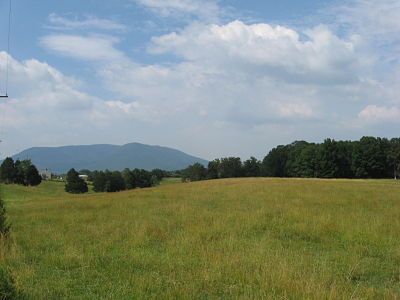
Out of this disaster comes one of the great legends of the Civil War. General Sheridan was called to Washington days before and has just returned to Winchester when the battle begins. Hearing the faint sounds of battle from his headquarters in Winchester, at first he is unconcerned, knowing of a scheduled reconnaissance in the area. But as the firing continues, he decides to get a closer look and leaves Winchester between 8:30 and 9:00 AM. Sheridan soon arrives on the battlefield where the Union soldiers are in total disarray. He mounts his horse, Rienzi, and makes his legendary ride on the battlefield, inspiring his troops to halt the Confederate advance. He spends the rest of the day organizing his command and deploying his men. By 4:00 PM he is ready to counterattack. Edward’s VIII Corps is still disorganized, but a few get assembled and form a column in reserve. The counterattack drives the Confederates back to their original line. As night descends, the Federals pursue General Early’s troops back to Cedar Creek and the Federals make camp where they had been positioned before the morning's surprise attack.
General Sheridan becomes a legend here on Cedar Creek battlefield by rallying his troops on his steed, Rienzi, and turning certain defeat into a decisive Union victory.

Below is artist Louis Prang's depiction of General Sheridan rallying his troops at the Battle of Cedar Creek. Thomas Buchanan Read wrote the poem "Sheridan's Ride" which immortalized the event and was memorized and recited by school children for years after the war. It was the most popular poem of the late nineteenth century- for Northerners.
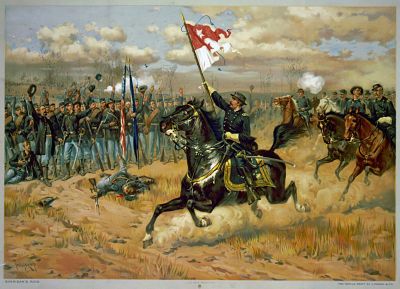
OCT 25 Edward becomes sick at Winchester, VA and is admitted to the hospital one week after the Battle of Cedar Creek.
NOV 5 Edward is admitted to the army hospital in Cumberland, MD (probably the large facility at Clarysville, just outside of Cumberland). He is diagnosed with typho-malarial fever, or what was known as "camp fever" during the Civil War. The symptoms include a pronounced chill followed by an intermittent fever, abdominal tenderness, nausea, diarrhea, retention of urine and a heavy coating or furring of the tongue.
This hospital record lists Edward Wallick's birthplace (nativity) as Shackland County, Ohio. There is no such county in Ohio and it is obviously a perversion of Coshocton County. Misspellings are commonplace in Civil War records.
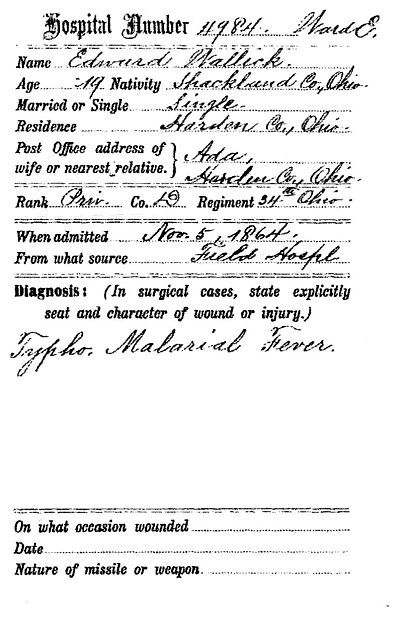
DEC Edward is still hospitalized. However, one record states he is on furlough for a time in December. Perhaps he goes home for Christmas.
1865
JAN- The record is vague, but Edward may have been able to rejoin the 34th Ohio for a time in January and February, 1865.
Two records showing that Edward Wallick was transferred from the 34th Ohio to the 36th Ohio, but he spent little time with his new regiment because of chronic illness. Notice the two spellings for "Wallick" on the index cards from the National Archives.
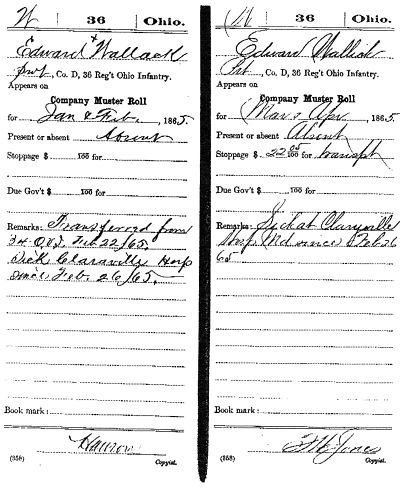
FEB 26-MAY 30 Edward is again admitted to Clarysville Army Hospital near Cumberland, MD and will remain hospitalized there for the rest of his enlistment. He is discharged May 30, 1865 under General Orders #77 (same discharge Elijah Wallick received) with a surgeon’s certificate of disability. This General Order states that “all volunteer soldiers who need no further treatment in army hospitals are to be honorably discharged from service with immediate payment and all prisoners-of-war treated the same.”
Edward fulfills his military obligation and returns to Ada, Ohio, in June, 1865. He marries Hanna Jane Stroud on December 18, 1872 and they have five children who survive to adulthood. By 1910 Edward has moved to Portland, Oregon and there he dies on October 20, 1918. Edward Wallick is buried in Multnomah Park Cemetery, Portland, OR.
Edward Wallick's gravestone at Multnomah Park Cemetery, Portland OR.

Comrade-in-Arms
Brother
Isaiah 49th Ohio- mortally wounded at Missionary Ridge.
Song- Weeping, Sad and Lonely
Some regimental commanders forbid the playing of some songs, for they felt the songs contributed to homesickness and as a result, desertion. For example, here a sweetheart sings of her soldier and lover:
Weeping, Sad and Lonely- vs. 3
If amid the din of battle,
Nobly you should fall,
Far away from those who love you,
None to hear you call.
Who would whisper words of comfort,
Who would soothe your pain,
Ah! the many cruel fancies,
Ever in my brain.
Chorus
Weeping, sad and lonely,
Hopes and fears, how vain.
When this cruel war is over,
Praying! that we meet again.
A special thanks to Ron Wallick and Mary (Wallick) Stierhoff for their help with this biography. Ron was instrumental in acquiring the photos of Edward and his gravestone at Multnomah Park Cemetery and Mary supplied regimental information from the National Archives about her great-grandfather.
Return to Top
Return to Wallick Family Website
